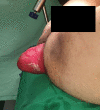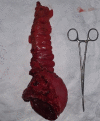A 54-Year-Old Man with a Large Rectal Prolapse Treated with Perineal Proctosigmoidectomy with Levatorplasty (Altemeier Procedure): Presentation of Case and Review of Literature
- PMID: 37259488
- PMCID: PMC10241106
- DOI: 10.12659/AJCR.939508
A 54-Year-Old Man with a Large Rectal Prolapse Treated with Perineal Proctosigmoidectomy with Levatorplasty (Altemeier Procedure): Presentation of Case and Review of Literature
Abstract
BACKGROUND The surgical procedure of perineal proctosigmoidectomy with levatorplasty is known as the Altemeier procedure. This report presents the case of a 54-year-old man with a large rectal prolapse treated with perineal proctosigmoidectomy with levatorplasty (Altemeier procedure). CASE REPORT A 54-year-old male had a large bulging in the rectum since 5 months ago. At first, the bulging was small, but its size had increased to approximately 10 cm at presentation. The patient also stated that the bulging used to reduce spontaneously after defecating or manually by applying sufficient pressure, but lately it had been irreducible. Another concern was chronic constipation over the last few years, which was treated with over-the-counter laxatives and stool softeners. Physical examination of the perianal region revealed a full-thickness, irreducible, prolapsed bowel segment, approximately 10 cm long, with multiple mucosal ulcerations. Grade V rectal prolapse was diagnosed. Follow-up at 7, 14, and 30 days after surgery showed complete resolution of symptoms and no recurrence. CONCLUSIONS Individually tailored and prompt surgical treatment for all patients with rectal prolapse is vital. The Altemeier procedure, which has good efficacy with low morbidity, complications, and recurrence, should be considered in elderly patients with an irreducible, large rectal prolapse.
Conflict of interest statement
Figures





Similar articles
-
Perineal Rectosigmoidectomy (Altemeier Procedure) as Treatment of Strangulated Rectal Prolapse.J Gastrointest Surg. 2016 Dec;20(12):2102-2103. doi: 10.1007/s11605-016-3190-3. Epub 2016 Jul 6. J Gastrointest Surg. 2016. PMID: 27384429
-
Long-term outcome of perineal rectosigmoidectomy for rectal prolapse.Int J Surg. 2016 Aug;32:78-82. doi: 10.1016/j.ijsu.2016.06.040. Epub 2016 Jun 23. Int J Surg. 2016. PMID: 27345263
-
[Efficacy of Altemeier procedure in the treatment of rectal prolapse].Zhonghua Wei Chang Wai Ke Za Zhi. 2017 Dec 25;20(12):1370-1374. Zhonghua Wei Chang Wai Ke Za Zhi. 2017. PMID: 29280119 Chinese.
-
Modified Altemeier Procedure as Management for Incarcerated Rectal Prolapse in a Young Healthy Male Patient: A Case Report and Literature Review.Medicina (Kaunas). 2024 Nov 15;60(11):1872. doi: 10.3390/medicina60111872. Medicina (Kaunas). 2024. PMID: 39597057 Free PMC article. Review.
-
[Strangled rectal prolapse in young adults: about a case and review of the literature].Pan Afr Med J. 2016 Oct 3;25:60. doi: 10.11604/pamj.2016.25.60.10721. eCollection 2016. Pan Afr Med J. 2016. PMID: 28250884 Free PMC article. Review. French.
References
-
- Segal J, McKeown DG, Tavarez MM. Rectal prolapse. Treasure Island (FL): StatPearls Publishing; 2022. Available from: https://www.ncbi.nlm.nih.gov/books/NBK532308/ - PubMed
-
- Bordeianou L, Paquette I, Johnson E, et al. Clinical practice guidelines for the treatment of rectal prolapse. Dis Colon Rectum. 2017;60(11):1121–31. - PubMed
Publication types
MeSH terms
LinkOut - more resources
Full Text Sources
Medical

